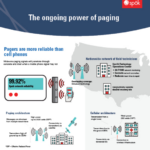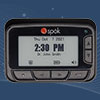Blog
Pagers’ popularity: 5 reasons it’s still a top communication tool in healthcare
From tech startups to mainstream news publications, many have decried the use of the pager in healthcare. They’ve compared it to the fax machine, and questioned its purpose in the age of universal smartphone use.
Yet pagers are still here: Nearly 50 percent of hospitals support in-house/onsite pagers, 35 percent support wide-area pagers, and 21 percent support encrypted pagers, according to our latest communication survey. The continued popularity of pagers in healthcare has surprised everyone—the high usage rate has even surprised us here at Spok—and they’re not going anywhere anytime soon. Why?
Let’s explore five key reasons why paging has a long life ahead of it in healthcare:
1. Unbeatable reliability
Spok fully supports care team communication across many devices, including smartphones, tablets, and WiFi phones. We recognize the capabilities and benefits that come along with a smart device, and offer an intuitive, multi-device application for secure care team messaging. However, the reality is that the majority of hospitals choose to complement communications on those devices with paging because those devices aren’t always reliable. Anyone who has worked in or visited a hospital knows that the facilities are often labyrinths of concrete and steel, and messages sent over a cellular or spotty WiFi network may not be delivered successfully. And in healthcare, you need information to be delivered—lives are on the line, and every second counts. The Spok paging network, the largest in the U.S., offers 99.92 percent reliability, and delivers over 100 millionmessages each month. When you have a patient who is in dire need, you can be certain that the on-call hospitalist or rapid response team gets that alert or message immediately.
2. The right device for the right role
If you have a robust infrastructure for secure messaging, perhaps smartphones are the best fit for your physicians and nurses. But what about the nonclinical members of the care team, such as housekeepers, transport technicians, and phlebotomists? Fifty-four percent of respondents to our recent mobility survey said the pager is the primary communication device for these roles, handily beating Wi-Fi phones (15 percent), smartphones (14 percent), and voice badges (7 percent). These roles typically don’t need EHR access, clinical decision support, or other clinically-focused applications, so the inexpensive pager fulfills their communication needs. A diverse device mix ensures each staff member has the mobile device best suited to the nature of their work and reduces service and maintenance costs.
3. Patient data protection
Whether you have clinical or nonclinical roles using pagers, all members of the care team likely have instances where they need to communicate protected health information (PHI) in their pages. That didn’t use to be an option—or at least, an advisable one. Standard pagers send information over open radio waves that have the potential to be intercepted. While this type of security breach is both rare and illegal, it’s certainly not worth putting patient data at risk. In 2015, Spok introduced our proprietary one-way and two-way encrypted pagers. The T5 and T52 pagers are fully secure and HIPAA-compliant, so care team members can safely send any and all information needed to efficiently coordinate care, including patient name, DOB, room, condition, etc., without worry. Each message is fully encrypted with the industry standard AES-128* encryption algorithm, and each device is programmed with a unique key. With the additional display-lock security features and remote data-wipe, the encrypted pager is a powerful tool for fast, reliable, and secure communication. Learn more about standard vs. encrypted pagersand which is best for your hospital.
4. A trusted partner for disaster response
Another area in which pagers excel is disaster response. When disaster strikes or outages occur that render standard communication channels useless, what is your backup plan? How will your staff continue communicating when networks are down and continue delivering care to patients? In the same mobility survey, 77 percent reported in-house pagers are in place for use during emergencies, and 47 percent said they were part of the hospital business continuity plan. Wide-area pagers, including encrypted pagers, weren’t far behind at 66 percent in place for use during emergencies and 58% of the time they are part of the business continuity plan. The reliance on wide-area pagers is likely due to their ability to work using a simple battery to connect to an extensive, highly reliable external network unrelated to any hospital servers or infrastructure.
5. Investment in paging’s future
Paging is hardly standing on its last legs: Spok is continuing to invest in its paging network to increase reliability and value for our customers. At the end of 2018, we completed a six-year project to replace all Glenayre GL3000 paging terminals, the standard for paging carriers beginning in the late 1980s, with PAT1K paging terminals that support off-the-shelf server hardware and modern OS (Linux) and interfaces (T1, SIP, TAP). Spok owns the intellectual property from Glenayre, so we are the only paging carrier capable of using state-of-the-art hardware, which serves as the backbone of the paging network. These new PAT1K paging terminals combined provide a highly reliable platform that will take Spok paging into the future—our team is committed to supporting paging to our fullest ability for as long as our customers demand it.
1 million strong
Paging isn’t for everyone, but when it comes to critical communications in healthcare, it’s still a powerful tool. It’s popular for its reliability, simplicity, and longevity among physicians and nurses on the frontline of care, as well as nonclinical care team members “behind the scenes.” There have been more than one million paging subscribers on the Spok paging network for the last several years, and many hospitals are investing in the future of paging by introducing encrypted pagers. The future of paging is bright, and Spok is here not only to support, but to advance its reliability, to support easier care collaboration, swift response, and ultimately, better patient outcomes.





